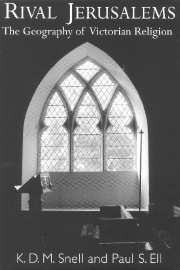Book contents
- Frontmatter
- Contents
- List of figures
- List of tables
- Preface and acknowledgements
- Introduction
- Part 1 Religious geographies: the districts of England and Wales
- 1 The 1851 Census of Religious Worship
- 2 The Church of England
- 3 Old dissent: the Presbyterians, Independents, Baptists, Quakers and Unitarians
- 4 The geographies of new dissent
- 5 Roman Catholicism and Irish immigration
- 6 Denominational co-existence, reciprocity or exclusion?
- Part 2 Religion and locality: parish-level explorations
- Technical appendices
- Bibliography
- Index
2 - The Church of England
Published online by Cambridge University Press: 08 August 2009
- Frontmatter
- Contents
- List of figures
- List of tables
- Preface and acknowledgements
- Introduction
- Part 1 Religious geographies: the districts of England and Wales
- 1 The 1851 Census of Religious Worship
- 2 The Church of England
- 3 Old dissent: the Presbyterians, Independents, Baptists, Quakers and Unitarians
- 4 The geographies of new dissent
- 5 Roman Catholicism and Irish immigration
- 6 Denominational co-existence, reciprocity or exclusion?
- Part 2 Religion and locality: parish-level explorations
- Technical appendices
- Bibliography
- Index
Summary
Introduction
The Church of England was numerically by far the most important denomination in 1851. Its central position as the established church warrants treatment in its own right in this chapter, where our aim is to describe and (in general terms) account for its distribution in 1851. In doing this, we have used nearly the full range of possible Anglican variables, partly to indicate their mutually reinforcing character, and partly to familiarise readers with the variables and their distinctive qualities. These were produced and mapped for every denomination, but we will not provide such detail for other denominations in later chapters. The concentration there will usually be on the index of attendances. As outlined earlier, the analysis in these opening chapters focuses on the 624 registration districts of England and Wales.
In dealing separately with the Church of England, an important preamble should be made, for it is one that bears on comparisons between denominations. The Anglican Church is routinely criticised for its ‘inflexibility’ and failure to adapt to industrialising circumstances. We will see examples of this in the following pages, and this is a line that historians have readily adopted.
- Type
- Chapter
- Information
- Rival JerusalemsThe Geography of Victorian Religion, pp. 54 - 92Publisher: Cambridge University PressPrint publication year: 2000



